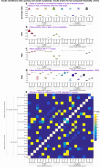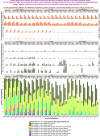Performance of qpAdm-based screens for genetic admixture on graph-shaped histories and stepping stone landscapes
- PMID: 40169722
- PMCID: PMC12118350
- DOI: 10.1093/genetics/iyaf047
Performance of qpAdm-based screens for genetic admixture on graph-shaped histories and stepping stone landscapes
Abstract
qpAdm is a statistical tool that is often used for testing large sets of alternative admixture models for a target population. Despite its popularity, qpAdm remains untested on 2D stepping stone landscapes and in situations with low prestudy odds (low ratio of true to false models). We tested high-throughput qpAdm protocols with typical properties such as number of source combinations per target, model complexity, model feasibility criteria, etc. Those protocols were applied to admixture graph-shaped and stepping stone simulated histories sampled randomly or systematically. We demonstrate that false discovery rates of high-throughput qpAdm protocols exceed 50% for many parameter combinations since: (1) prestudy odds are low and fall rapidly with increasing model complexity; (2) complex migration networks violate the assumptions of the method; hence, there is poor correlation between qpAdm P-values and model optimality, contributing to low but nonzero false-positive rate and low power; and (3) although admixture fraction estimates between 0 and 1 are largely restricted to symmetric configurations of sources around a target, a small fraction of asymmetric highly nonoptimal models have estimates in the same interval, contributing to the false-positive rate. We also reinterpret large sets of qpAdm models from 2 studies in terms of source-target distance and symmetry and suggest improvements to qpAdm protocols: (1) temporal stratification of targets and proxy sources in the case of admixture graph-shaped histories, (2) focused exploration of few models for increasing prestudy odds; and (3) dense landscape sampling for increasing power and stringent conditions on estimated admixture fractions for decreasing the false-positive rate.
Keywords: qpAdm; admixture graphs; archaeogenetics; genetic admixture; simulation; stepping stone models.
© The Author(s) 2025. Published by Oxford University Press on behalf of The Genetics Society of America.
Conflict of interest statement
Conflicts of interest: The author(s) declare no conflicts of interest.
Figures











Update of
-
Performance of qpAdm-based screens for genetic admixture on admixture-graph-shaped histories and stepping-stone landscapes.bioRxiv [Preprint]. 2025 Feb 3:2023.04.25.538339. doi: 10.1101/2023.04.25.538339. bioRxiv. 2025. Update in: Genetics. 2025 May 8;230(1):iyaf047. doi: 10.1093/genetics/iyaf047. PMID: 37904998 Free PMC article. Updated. Preprint.
Similar articles
-
Performance of qpAdm-based screens for genetic admixture on admixture-graph-shaped histories and stepping-stone landscapes.bioRxiv [Preprint]. 2025 Feb 3:2023.04.25.538339. doi: 10.1101/2023.04.25.538339. bioRxiv. 2025. Update in: Genetics. 2025 May 8;230(1):iyaf047. doi: 10.1093/genetics/iyaf047. PMID: 37904998 Free PMC article. Updated. Preprint.
-
Assessing the performance of qpAdm: a statistical tool for studying population admixture.Genetics. 2021 Apr 15;217(4):iyaa045. doi: 10.1093/genetics/iyaa045. Genetics. 2021. PMID: 33772284 Free PMC article.
-
Testing Times: Challenges in Disentangling Admixture Histories in Recent and Complex Demographies.bioRxiv [Preprint]. 2023 Nov 15:2023.11.13.566841. doi: 10.1101/2023.11.13.566841. bioRxiv. 2023. Update in: Genetics. 2024 Sep 4;228(1):iyae110. doi: 10.1093/genetics/iyae110. PMID: 38014190 Free PMC article. Updated. Preprint.
-
Admixture mapping and the role of population structure for localizing disease genes.Adv Genet. 2008;60:547-69. doi: 10.1016/S0065-2660(07)00419-1. Adv Genet. 2008. PMID: 18358332 Review.
-
Human population structure and genetic association studies.Pharmacogenomics. 2003 Jul;4(4):431-41. doi: 10.1517/phgs.4.4.431.22758. Pharmacogenomics. 2003. PMID: 12831322 Review.
Cited by
-
Ancient DNA reveals the prehistory of the Uralic and Yeniseian peoples.Nature. 2025 Aug;644(8075):122-132. doi: 10.1038/s41586-025-09189-3. Epub 2025 Jul 2. Nature. 2025. PMID: 40604287 Free PMC article.
-
The genomic footprints of migration: how ancient DNA reveals our history of mobility.Genome Biol. 2025 Jul 16;26(1):206. doi: 10.1186/s13059-025-03664-w. Genome Biol. 2025. PMID: 40671036 Free PMC article. Review.
-
Ancient DNA indicates 3,000 years of genetic continuity in the Northern Iranian Plateau, from the Copper Age to the Sassanid Empire.Sci Rep. 2025 May 13;15(1):16530. doi: 10.1038/s41598-025-99743-w. Sci Rep. 2025. PMID: 40360796 Free PMC article.
References
MeSH terms
Grants and funding
LinkOut - more resources
Full Text Sources

